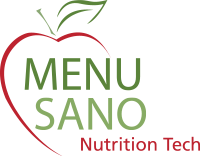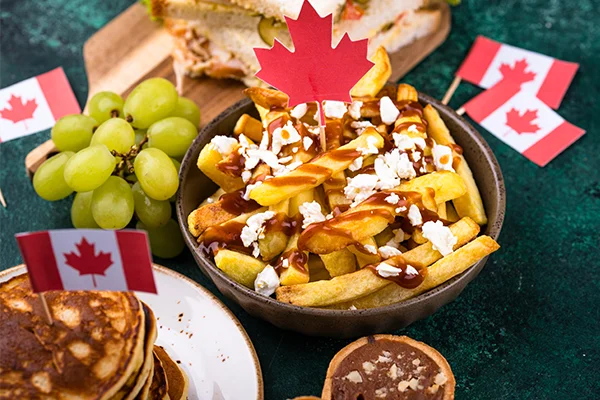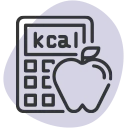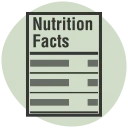Key Takeaways
- CFIA regulations require specific label fonts, sizes, and layouts for nutrition labels.
- Use easy-to-read sans-serif fonts like Arial or Helvetica for compliance.
- The minimum font size is 6 points for all core nutritional information.
- Formatting errors can result in non-compliance, fines, or label rejection.
- MenuSano automates CFIA-compliant nutrition label formatting for Canadian food businesses.
Why Font and Size Matter for Canadian Nutrition Labels
In Canada, nutrition labelling is governed by Health Canada and enforced by the Canadian Food Inspection Agency. Font style, size, and layout are not aesthetic preferences—they are legal requirements. Proper formatting is critical for both compliance and consumer clarity.
Using the wrong font, incorrect sizes, or poor spacing can lead to non-compliance issues, costing businesses time, money, and market credibility. This guide outlines CFIA-specific requirements for nutrition label fonts and sizes and how MenuSano simplifies compliance for Canadian food manufacturers.
CFIA-Approved Fonts for Nutrition Labels
Accepted Font Styles in Canada
In Canada, nutrition labels typically use sans-serif fonts such as Helvetica or Arial. The font must be clear and easy to read, with a minimum type size of 6 points. Certain elements, like “Calories” and the calorie amount, have specific font size requirements. The use of decorative or cursive fonts is not allowed.
On the other hand, Serif Font: Times New Roman is a serif font; it is unacceptable.
Examples of Different Label Formats
Standard Format – English
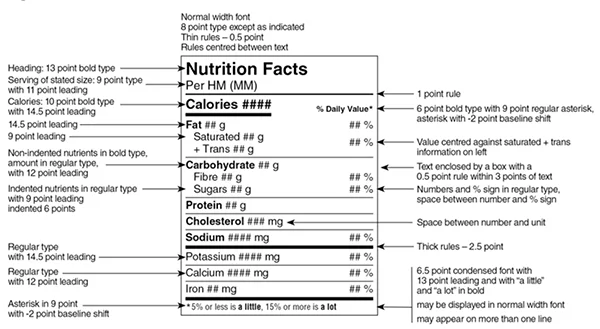
Source: Health Canada
- Nutrition Facts: 13 point bold type
- Serving Size: 9 point type
- Calories: 10 point bold type with 14.5 point leading
- Non-Indented Nutrients: bold type amount in regular type with 12 point leading
- Indented Nutrients: regular type with 9 point leading, indented 6 points
Standard Format – French
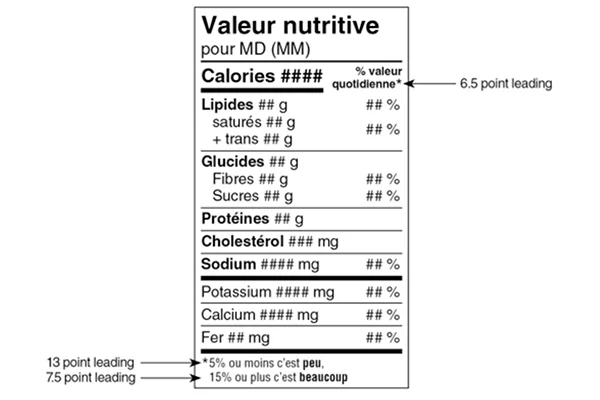
Same format specifications except for the following:
- Asterisk: 13 point leading and 7.5 point leading
- Daily Value or Valeur Quotidienne: 6.5 point leading
Bilingual Standard Format
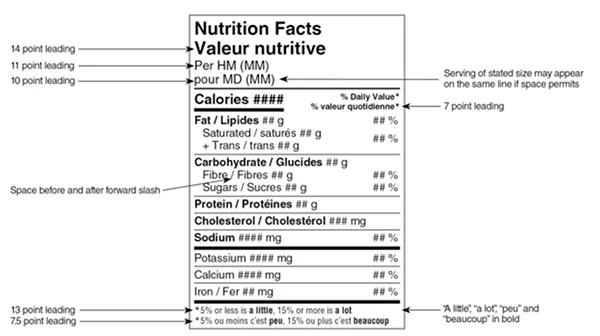
Same format specifications except for the following:
- French Heading (Valeur Nutritive): 14 point leading
- Serving Size – English: 11 point leading
- Serving Size – French: 10 point leading
- Daily Value or Valeur Quotidienne: 7 point leading
- Indented Nutrients: Space before and after forward slash
- Asterisk – English: 13 point leading
- Asterisk – French: 7.5 point leading
The order of languages may be reversed from the order shown in the image above.
Bilingual Horizontal Format
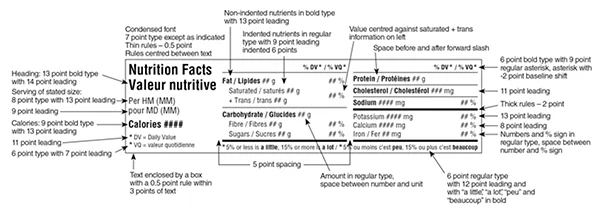
- Heading: 13 point bold type with 14 point leading
- Serving Size – English: 8 point type with 13 point leading
- Serving Size – French: 9 point leading
- Calories: 9 point bold type with 13 point leading
- Daily Value: 11 point leading
- Valeur Quotidienne: 6 point type with 7 point leading
- Non-Indented Nutrients: bold type with 13 point leading
- Indented Nutrients: regular type with 9 point leading, indented 6 points
The order of languages may be reversed from the order shown in the image above.
Bilingual Simplified Standard Format
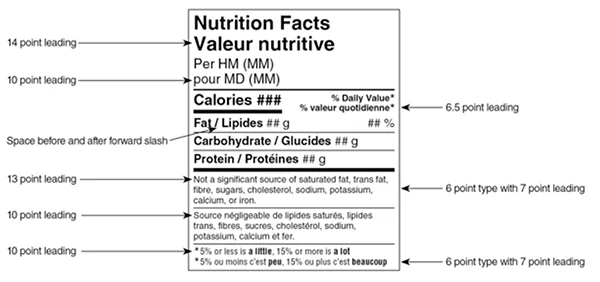
Same format specifications except for the following:
- French Heading (Valeur Nutritive): 14 point leading
- Serving Size – French: 10 point leading
- Valeur Quotidienne: 6.5 point leading
- Nutrients: Space before and after the forward slash
- Asterisk – English: 10 point leading
- Asterisk – French: 6 point type with 7 point leading
The order of languages may be reversed from the order shown in the image above.
Bilingual Simplified Horizontal Format

Same format specifications except for the following:
- Valeur Quotidienne: 7 point leading
- Nutrient Value %: 10 point leading
- Nutrient Value g: 11 point leading
- Divider: thick rule – 2.5 point
The order of languages may be reversed from the order shown in the image above.
Linear Format

Same format specifications except for the following:
- Heading: 10 point bold type
- Serving Size: 7.5 point
- Calories: 8 point
- Nutrients: 8 point leading
- Asterisk: 6 point regular type, right justified, with “a little” and “a lot” in bold
Standardized Cannabis Symbol
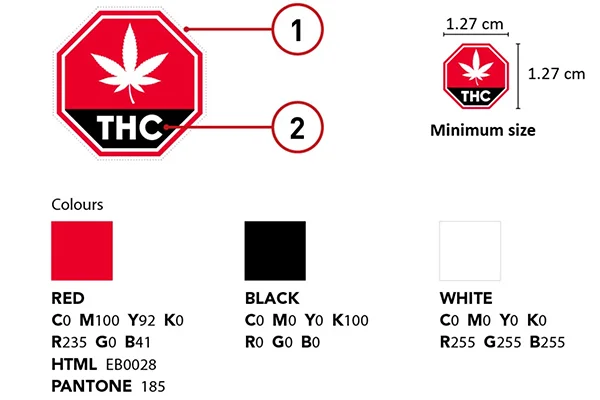
Source: Health Canada
- A white border of at least 2 points must surround all sides (the dotted line shown is for illustration only and not required).
- Positioned so the text can be read left to right when the container is viewed as it’s typically displayed or used.
Cannabis Health Warning Message with Attribution
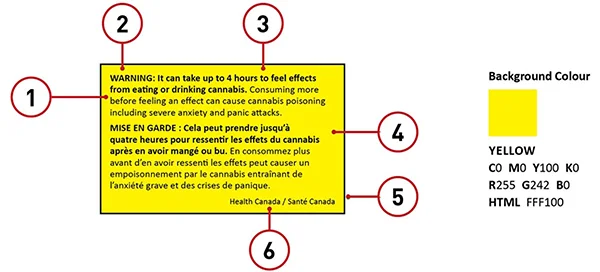
- The text must be left-aligned with no hyphenation. The second sentence should use sentence case. Use a standard sans-serif font in regular weight and width, without italics, in black. Line spacing must be at least 8 points. The font size must be at least 7 points and no smaller than the font used for the brand name.
- The word “WARNING” must be in uppercase letters and in bold type.
- The first sentence must be in sentence case, in bold type.
- Arranged so the text reads from left to right when the container is presented or seen as it normally would be during purchase or use.
- Enclosed within a solid black border at least 1 point thick, with a minimum 6-point space between the text and the border on all sides. There must be at least 3 points of space between the English and French messages if there is only one principal display panel.
- The source attribution must read “Health Canada / Santé Canada” if there’s one display panel or “Health Canada” and “Santé Canada” on separate English and French panels. Use a font size of at least 6 points, smaller than the health warning text.
Cannabis Nutrition Facts Table
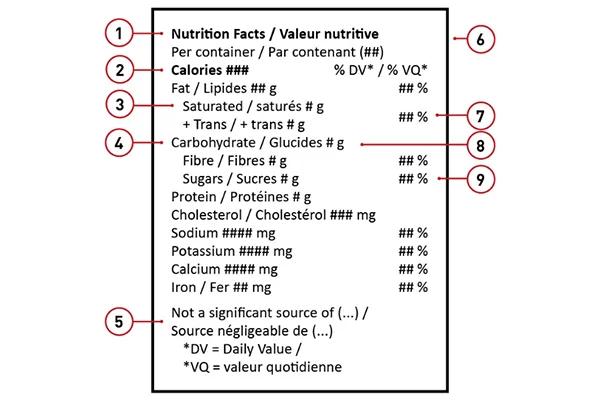
- Heading: Bold type
- Calories: Bold type
- Indented nutrients
- Non-indented nutrients
- Statement: Permitted, not required to appear in the nutrition facts table
- Black border that is a solid line of 1 point that has an inset of at least 6 points on all sides
- Value centred against saturated + trans information on the left
- Space between the number and the unit
- Space between the number and the % sign
Compliant Labels Made Easy with MenuSano
Manually formatting nutrition labels to meet CFIA standards is time-consuming and error-prone. One incorrect font size or misaligned row can mean compliance failure.
That’s why Canadian food businesses rely on MenuSano—a trusted nutrition analysis software and food labelling that automates compliance with CFIA’s complex formatting rules.
MenuSano’s Canadian Labelling Solution
MenuSano generates fully CFIA-compliant nutrition labels with just a few clicks. All Nutrition Facts tables created in MenuSano use pre-configured formatting. Simply input your ingredients, quantities, and servings, and MenuSano produces a formatted, print-ready label compliant with all Canadian food labelling laws.
Read more: The Ultimate Guide to FDA Nutrition Label Fonts and Sizes
Why Canadian Food Businesses Choose MenuSano
- Guaranteed CFIA compliance
- Templates for standard, horizontal, and simplified formats
- Bilingual English/French support
- Accurate calculation of nutrients and daily values
- No graphic design experience is required
- Time and cost savings
MenuSano gives Canadian food manufacturers peace of mind, knowing that every label meets regulatory standards and is ready for distribution across Canada.
Final Thoughts: Label Fonts and Sizes Rules Matter in Canada
In Canada, nutrition labelling must follow precise font and layout guidelines set by the CFIA. These rules aren’t optional—they’re legal obligations that protect consumers and ensure fair packaging practices.
Whether you’re labelling cookies, beverages, or frozen entrees, proper font usage can be the difference between a compliant product and one stuck in regulatory limbo.
With MenuSano, you can be confident that every nutrition label follows the latest CFIA regulations automatically and accurately.
